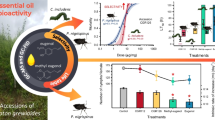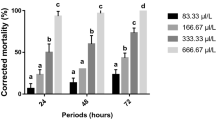Abstract
Novel biological control methods and integrated pest management strategies are basic requirements for the development of sustainable agriculture. As a result, there is a growing demand for research on the use of plant extracts and natural enemies such as the green lacewing, Ceraeochrysa claveri, as natural pest control methods. Studies have shown that although natural compounds such as neem oil (Azadirachta indica) are effective as pest control strategies, they also cause sublethal effects on nontarget insects, such as C. claveri. The aim of this study was to examine the effects of neem oil on C. claveri testes. C. claveri larvae were fed Diatraea saccharalis eggs, which were pretreated with 0.5%, 1%, and 2% neem oil. Testes were collected from larvae, pupae, and adults and analyzed using light and electron (transmission and scanning) microscopy. Changes in cellular stress and possible cell death were also determined by TUNEL assay and the marker HSP-70. The results showed that neem oil affects the organization and distribution of cysts in the testes and the normal sequence of cyst development, causing a delay in spermatogenesis in the testes of treated insects. Tests for cellular stress and DNA fragmentation indicated there was no cellular alteration in the treated groups. Although neem oil does not induce cell death or changes in HSP-70 expression, this biopesticide negatively impacts the process of spermatogenesis and could decrease the perpetuation of this species in the agroecosystem, indicating that the use of neem oil in association with green lacewings as a biological control should be carefully evaluated.




Similar content being viewed by others
References
Afzelius BA, Dallai R (1988) Spermatozoa of Megaloptera and Raphidioptera (Insecta, Neuropteroidea). J Ultra Mol Struct R 101:185–191
Baum JS, JPSt G, Mccall K (2005) Programmed cell death in the germline. Semin Cell Dev Biol 16:245–259
Benelli G, Buttazzoni L, Canale A, D’Andrea A, Serrone PD, Delrio G, Foxi C, Mariani S, Savini G, Vadivalagan C, Murugan K, Toniolo C, Nicoletti M, Serafini M (2017) Bluetongue outbreaks: looking for effective control strategies against Culicoides vectors. Res Vet Sci 115:263–270
Cagan RL (2003) Spermatogenesis: borrowing the apoptotic machinery. Curr Biol 13:600–602
Cherry R, Nuessly G (2010) Repellency of the biopesticide, azadirachtin, to wireworms (Coleoptera: Elateridae). Fla Entomol 93(1):52–55
Cloyd RA (2012) Indirect effects of pesticides on natural enemies. In: Soundararajan RP (ed) Pesticides-advances in chemical and botanical pesticides. Intech, Rijeka, pp 127–150. https://doi.org/10.5772/47244
Copping LG, Duke SO (2007) Natural products that have been used commercially as crop protection agents. Pest Manag Sci 63(6):524–554
Cruz-Landim C (2001) Organization of the cysts in bee (Hymenoptera, Apidae) testis: number of spermatozoa per cyst. Iheringia Sér Zool (91):183–189
da Silva CV, Schneider LCL, Conte H (2013) Toxicity and residual activity of a commercial formulation of oil from neem, Azadirachta indica A. Juss. (Meliaceae), in the embryonic development of Diatraea saccharalis F. (Lepidoptera: Crambidae). J Biofertil Biopestici 4:1–5
Dayan FE, Cantrell CL, Duke SO (2009) Natural products in crop protection. Bioorg Med Chem 17(12):4022–4034
De Freitas S, Penny ND (2001) The green lacewings (Neuroptera: Chrysopidae) of Brazilian agro-ecosystems. Proc Calif Acad Sci 52(19):245–395
Desneux N, Decourtye A, Delpuech JM (2007) The sublethal effects of pesticides on beneficial arthropods. Annu Rev Entomol 52:81–106
Dix DJ (1997a) Hsp 70 expression and function during gametogenesis. Cell Stress Chaperon 2(2):73–77
Dix DJ (1997b) Stress protein in reproductive toxicology. Environ Health Perspect 105(4):436–438
Dumser JB (1980) The regulation of spermatogenesis in insects. Annu Rev Entomol 25:341–369
Friedländer M, Jeshtadi A, Reynolds SE (2005) The structural mechanism of trypsin-induced intrinsic motility in Manduca sexta spermatozoa in vitro. J Insect Physiol 47:245–255
Ghazawi NA, El-Shranoubi ED, El-Shazly MM, Abdel-Rahman KM (2007) Effects of azadirachtin on mortality rate and reproductive system of the grasshopper Heteracris littoralis Ramb. (Orthoptera: Acrididae). J Orthopt Res 16(1):57–65
Gonzalez-Coloma A, Reina M, Diaz CE, Fraga BM (2010) Natural product-based biopesticides for insect control. In: Mander L, Liu HW (eds) Comprehensive natural products II. Elsevier, Oxford, pp 237–268
Isman MB (2006) Botanical insecticides, deterrents, and repellents in modern agriculture and an increasingly regulated world. Annu Rev Entomol 55:45–66
Linton YM, Nisbet AJ, Mordue (Luntz) AJ (1997) The effects of azadirachtin on the testes of the desert locust, Schistocerca gregaria (Forskal). J Insect Physiol 43(11):1077–1084
Martínez LC, Plata-Rueda A, Zanuncio JC, Serrão JE (2015) Bioactivity of six plant extracts on adults of Demotispa neivai (Coleoptera: Chrysomelidae). J Insect Sci 15:34
Mordue (Luntz) AJ, Blackwell A (1993) Azadirachtin: an update. J Insect Physiol 39:903–924
Morgan ED (2009) Azadirachtin, a scientific gold mine. Bioorg Med Chem 17:4096–4105
Mukhopadhyay I, Siddique HR, Bajpai VK, Saxena DK, Chowdhuri DK (2006) Synthetic pyrethroid cypermethrin induced cellular damage in reproductive tissues of Drosophila melanogaster: Hsp 70 as a marker of cellular damage. Arch Environ Contam Toxicol 51:673–680
Name KPO, Reis GPF, Báo SN (2007) An ultrastructural study of spermiogenesis in two species of Sitophilus (Coleoptera: Curculionidae). Biocell 31(2):229–236
Name KPO, Barros-Cordeiro KB, Filho JBG, Wolff M, Pujol-Luz JR, Báo SN (2012) Structure and ultrastructure of spermatozoa and spermiogenesis in three species of Lucilia Robineau-desvoidy, 1830 (Diptera: Calliphoridae). J Morphol 273:160–172
Nasiruddin M, Mordue (Luntz) AJ (1993) The effect of azadirachtin on the midgut histology of the locusts Schistocerca gregaria and Locusta migratoria. Tissue Cell 25(6):875–884
Nisbet AJ, Mordue AJ, Mordue W (1995) Detection of [22,23-3H2] dihydroazadirachtin binding sites on Schistocerca gregaria (Forskal) testes membranes. Insect Biochem Molec Biol 25(5):551–557
Nisbet AJ, Mordue (Luntz) AJ, Williams LM, Hannah L, Jennens L, Ley SV, Mordue W (1996) Autoradiographic localization of [22,23-3H2] dihydroazadirachtin binding sites in desert locust testes and effects of azadirachtin on sperm motility. Tissue Cell 28(6):725–729
Ott GJ, Shirkey NJ, Haimo LT, Cardullo RA, Thaler CD (2015) Germ-cell hub position in a Heteropteran testis correlates with the sequence and location of spermatogenesis and production of elaborate sperm bundles. Mol Reprod Dev 82:295–304
Özyurt N, Candan S, Suludere Z (2013) The morphology and histology of the male reproductive system in Dolycoris baccarum Linnaeus 1758 (Heteroptera: Pentatomidae) - light and scanning electron micoscope studies. Micron 44:101–106
Paccagnini E, Mercati D, Giusti F, Conti B, Dallai R (2010) The spermatogenesis and the sperm structure of Terebrantia (Thysanoptera, Insecta). Tissue Cell 42:247–258
Paoli F, Gottardo M, Dallai R, Roversi PF (2013) Morphology of the male reproductive system and sperm ultrastructure of the egg parasitoid Gryon pennsylvanicum (Ashmead) (Hymenoptera, Platygastridae). Arthropod Struct Dev 42:297–308
Pappas ML, Broufas GD, Koveos DS (2011) Chrysopidae predators and their role in biological control. J Entomol 8(3):301–326
Pearse AGE (1972) Histochemistry theoretical and applied. Churchill Livingstone, Edinburgh
Phillips DM (1970) Insect sperm: their structure and morphogenesis. J Cell Biol 44(2):243–277
Polanska MA, Ciuk MA, Cymborowski B, Bebas P (2005) Germ cell death in the testis and its relation to spermatogenesis in the wax moth, Galleria mellonella (Lepidoptera: Pyralidae), effects of facultative diapause. J Exp Zool 303A:1013–1029
Rego LNAA, Silistino-Souza R, Azeredo-Oliveira MTV, Madi-Ravazzi L (2013) Spermatogenesis of Zaprionus indianus and Zaprionus sepsoides (Diptera, Drosophilidae): cytochemical, structural and ultrastructural characterization. Genet Mol Biol 36(1):50–60
Schmutterer H (1990) Properties and potential of natural pesticides from the neem tree, Azadirachta indica. Annu Rev Entomol 35:271–297
Scudeler EL, Santos DC (2013) Effects of neem oil (Azadirachta indica A. Juss) on midgut cells of predatory larvae Ceraeochrysa claveri (Navás, 1911) (Neuroptera: Chrysopidae). Micron 44:125–132
Scudeler EL, Santos DC (2014) Side effects of neem oil on the midgut endocrine cells of the green lacewing Ceraeochrysa claveri (Navás) (Neuroptera: Chrysopidae). Neotrop Entomol 43:154–160
Scudeler EL, Garcia ASG, Padovani CR, Santos DC (2013) Action of neem oil (Azadirachta indica A. Juss) on cocoon spinning in Ceraeochrysa claveri (Neuroptera: Chrysopidae). Ecotoxicol Environ Saf 97:176–182
Scudeler EL, Padovani CR, Santos DC (2014) Effects of neem oil (Azadirachta indica A. Juss) on the replacement of the midgut epithelium in the lacewing Ceraeochrysa claveri during larval-pupal metamorphosis. Acta Histochem 116:771–780. https://doi.org/10.1016/j.acthis.2014.01.008
Scudeler EL, Garcia ASG, Padovani CR, Pinheiro PFF, Santos DC (2016) Cytotoxic effects of neem oil in the midgut of the predator Ceraeochrysa claveri. Micron 80:96–111
Shimizu T (1988) Suppressive effects of azadirachtin on spermiogenesis of the diapausing cabbage army worm, Mamestra brassicae, in vitro. Entomol Exp Appl 46:197–199
Silva-Zacarin ECM, Gregorc A, Moraes RLMS (2006) In situ localization of heat-shock proteins and cell death labelling in the salivary gland of acaricide-treated honeybee larvae. Apidologie 37:507–516. https://doi.org/10.1051/apido:2006030
Sukontason KL, Chaiwong T, Chaisri U, Kurahashi H, Sanford M, Sukontason K (2011) Reproductive organ of blow fly, Chrysomya megacephala (Diptera: Calliphoridae): ultrastructural of testis. J Parasitol Res. https://doi.org/10.1155/2011/690863
Szöllösi A (1982) Relationships between germ and somatic cells in the testes of locusts and moths. In: King RC, Akai H (eds) Insect Ultrastructure. Plenum Press, New York, pp 32–60
Tayade DV (2012) Effect of phytochemical azadirachtin on the morphology and cytology of the testis follicle of the Indian grasshopper, Melanoplus sanguinipes. Biosci Discov 3(1):79–81
Wang X, Chen M, Zhou J, Zhang X (2014) HSP27, 70 and 90, anti-apoptotic proteins, in clinical cancer therapy (review). Int J Oncol 45:18–30. https://doi.org/10.3892/ijo.2014.2399
Wu YF, Wei LS, Torres MA, Zhang X, Wu SP, Chen H (2017) Morphology of the male reproductive system and spermiogenesis of Dendroctonus armandi Tsai and Li (Coleoptera: Curculionidae: Scolytinae). J Insect Sci 17(1):20 1–9
Zizzari ZV, Lupetti P, Mencarelli C, Dallai R (2008) Sperm ultrastructure and spermiogenesis of Coniopterygidae (Neuroptera, Insecta). Arthropod Struct Dev 37:410–417
Acknowledgments
We are grateful to the Electron Microscopy Center of the Institute of Biosciences of Botucatu, UNESP.
Funding
This study was funded by the Fundação de Amparo à Pesquisa do Estado de São Paulo - FAPESP (2012/02879-7 and 2014/15016-2).
Author information
Authors and Affiliations
Corresponding author
Ethics declarations
Conflict of interest
The authors declare that they have no conflict of interest.
Ethical approval
All applicable international, national, and/or institutional guidelines for the care and use of animals were followed.
Additional information
Handling Editor: Georg Krohne
Rights and permissions
About this article
Cite this article
Garcia, A.S.G., Scudeler, E.L., Pinheiro, P.F.F. et al. Can exposure to neem oil affect the spermatogenesis of predator Ceraeochrysa claveri?. Protoplasma 256, 693–701 (2019). https://doi.org/10.1007/s00709-018-1329-7
Received:
Accepted:
Published:
Issue Date:
DOI: https://doi.org/10.1007/s00709-018-1329-7




